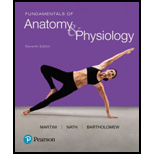
Fundamentals of Anatomy & Physiology (11th Edition)
11th Edition
ISBN: 9780134396026
Author: Frederic H. Martini, Judi L. Nath, Edwin F. Bartholomew
Publisher: PEARSON
expand_more
expand_more
format_list_bulleted
Question
Chapter 18, Problem 15RQ
Summary Introduction
To determine:
Two hormones that are secreted by the kidney and their importance.
Introduction:
Kidneys are the important organs that carry out the process of ultra-filtration, a process through which our blood is filtered. The waste, toxic materials that are produced by our body during
Expert Solution & Answer
Want to see the full answer?
Check out a sample textbook solution
Students have asked these similar questions
What is behavioral adapt
22. Which of the following mutant proteins is expected to have a dominant negative effect when over-
expressed in normal cells?
a. mutant PI3-kinase that lacks the SH2 domain but retains the kinase function
b. mutant Grb2 protein that cannot bind to RTK
c. mutant RTK that lacks the extracellular domain
d. mutant PDK that has the PH domain but lost the kinase function
e. all of the above
What is the label ?
Chapter 18 Solutions
Fundamentals of Anatomy & Physiology (11th Edition)
Ch. 18 - Prob. 1CPCh. 18 - Describe paracrine communication.Ch. 18 - Identify five mechanisms of intercellular...Ch. 18 - What primary factor determines each cells hormonal...Ch. 18 - Prob. 5CPCh. 18 - Prob. 6CPCh. 18 - Prob. 7CPCh. 18 - If a person were dehydrated, how would the amount...Ch. 18 - Prob. 9CPCh. 18 - Prob. 10CP
Ch. 18 - Prob. 11CPCh. 18 - Prob. 12CPCh. 18 - When a persons thyroid gland is removed, signs of...Ch. 18 - Prob. 14CPCh. 18 - Prob. 15CPCh. 18 - Prob. 16CPCh. 18 - Prob. 17CPCh. 18 - Prob. 18CPCh. 18 - Prob. 19CPCh. 18 - Prob. 20CPCh. 18 - Increased amounts of light would inhibit the...Ch. 18 - Prob. 22CPCh. 18 - Prob. 23CPCh. 18 - Prob. 24CPCh. 18 - Prob. 25CPCh. 18 - Prob. 26CPCh. 18 - Prob. 27CPCh. 18 - Prob. 28CPCh. 18 - Prob. 29CPCh. 18 - The lack of which hormones would inhibit skeletal...Ch. 18 - Prob. 31CPCh. 18 - Prob. 32CPCh. 18 - Prob. 33CPCh. 18 - Prob. 1RQCh. 18 - Prob. 2RQCh. 18 - Prob. 3RQCh. 18 - Prob. 4RQCh. 18 - The two hormones released by the posterior lobe of...Ch. 18 - Prob. 6RQCh. 18 - Prob. 7RQCh. 18 - Prob. 8RQCh. 18 - Prob. 9RQCh. 18 - Prob. 10RQCh. 18 - Prob. 11RQCh. 18 - Prob. 12RQCh. 18 - Prob. 13RQCh. 18 - Prob. 14RQCh. 18 - Prob. 15RQCh. 18 - Prob. 16RQCh. 18 - Prob. 17RQCh. 18 - What is the primary difference in the way the...Ch. 18 - Prob. 19RQCh. 18 - Prob. 20RQCh. 18 - Prob. 21RQCh. 18 - Prob. 22RQCh. 18 - Prob. 23RQCh. 18 - Prob. 24RQCh. 18 - Prob. 25RQCh. 18 - Prob. 26RQCh. 18 - Prob. 27RQCh. 18 - Prob. 28RQCh. 18 - Prob. 29RQCh. 18 - Prob. 1CCCh. 18 - Prob. 2CC
Knowledge Booster
Learn more about
Need a deep-dive on the concept behind this application? Look no further. Learn more about this topic, biology and related others by exploring similar questions and additional content below.Similar questions
- Can you described the image? Can you explain the question as well their answer and how to get to an answer to an problem like this?arrow_forwardglg 112 mid unit assignment Identifying melting processesarrow_forwardGive only the mode of inheritance consistent with all three pedigrees and only two reasons that support this, nothing more, (it shouldn't take too long)arrow_forward
- Oarrow_forwardDescribe the principle of homeostasis.arrow_forwardExplain how the hormones of the glands listed below travel around the body to target organs and tissues : Pituitary gland Hypothalamus Thyroid Parathyroid Adrenal Pineal Pancreas(islets of langerhans) Gonads (testes and ovaries) Placentaarrow_forward
- What are the functions of the hormones produced in the glands listed below: Pituitary gland Hypothalamus Thyroid Parathyroid Adrenal Pineal Pancreas(islets of langerhans) Gonads (testes and ovaries) Placentaarrow_forwardDescribe the hormones produced in the glands listed below: Pituitary gland Hypothalamus Thyroid Parathyroid Adrenal Pineal Pancreas(islets of langerhans) Gonads (testes and ovaries) Placentaarrow_forwardPlease help me calculate drug dosage from the following information: Patient weight: 35 pounds, so 15.9 kilograms (got this by dividing 35 pounds by 2.2 kilograms) Drug dose: 0.05mg/kg Drug concentration: 2mg/mLarrow_forward
- A 25-year-old woman presents to the emergency department with a 2-day history of fever, chills, severe headache, and confusion. She recently returned from a trip to sub-Saharan Africa, where she did not take malaria prophylaxis. On examination, she is febrile (39.8°C/103.6°F) and hypotensive. Laboratory studies reveal hemoglobin of 8.0 g/dL, platelet count of 50,000/μL, and evidence of hemoglobinuria. A peripheral blood smear shows ring forms and banana-shaped gametocytes. Which of the following Plasmodium species is most likely responsible for her severe symptoms? A. Plasmodium vivax B. Plasmodium ovale C. Plasmodium malariae D. Plasmodium falciparumarrow_forwardStandard Concentration (caffeine) mg/L Absorbance Reading 10 0.322 20 0.697 40 1.535 60 2.520 80 3.100arrow_forwardPlease draw in the missing answer, thank youarrow_forward
arrow_back_ios
SEE MORE QUESTIONS
arrow_forward_ios
Recommended textbooks for you
 Human Physiology: From Cells to Systems (MindTap ...BiologyISBN:9781285866932Author:Lauralee SherwoodPublisher:Cengage Learning
Human Physiology: From Cells to Systems (MindTap ...BiologyISBN:9781285866932Author:Lauralee SherwoodPublisher:Cengage Learning Human Biology (MindTap Course List)BiologyISBN:9781305112100Author:Cecie Starr, Beverly McMillanPublisher:Cengage Learning
Human Biology (MindTap Course List)BiologyISBN:9781305112100Author:Cecie Starr, Beverly McMillanPublisher:Cengage Learning Principles Of Radiographic Imaging: An Art And A ...Health & NutritionISBN:9781337711067Author:Richard R. Carlton, Arlene M. Adler, Vesna BalacPublisher:Cengage Learning
Principles Of Radiographic Imaging: An Art And A ...Health & NutritionISBN:9781337711067Author:Richard R. Carlton, Arlene M. Adler, Vesna BalacPublisher:Cengage Learning

Human Physiology: From Cells to Systems (MindTap ...
Biology
ISBN:9781285866932
Author:Lauralee Sherwood
Publisher:Cengage Learning


Human Biology (MindTap Course List)
Biology
ISBN:9781305112100
Author:Cecie Starr, Beverly McMillan
Publisher:Cengage Learning

Principles Of Radiographic Imaging: An Art And A ...
Health & Nutrition
ISBN:9781337711067
Author:Richard R. Carlton, Arlene M. Adler, Vesna Balac
Publisher:Cengage Learning


Great Glands - Your Endocrine System: CrashCourse Biology #33; Author: CrashCourse;https://www.youtube.com/watch?v=WVrlHH14q3o;License: Standard Youtube License